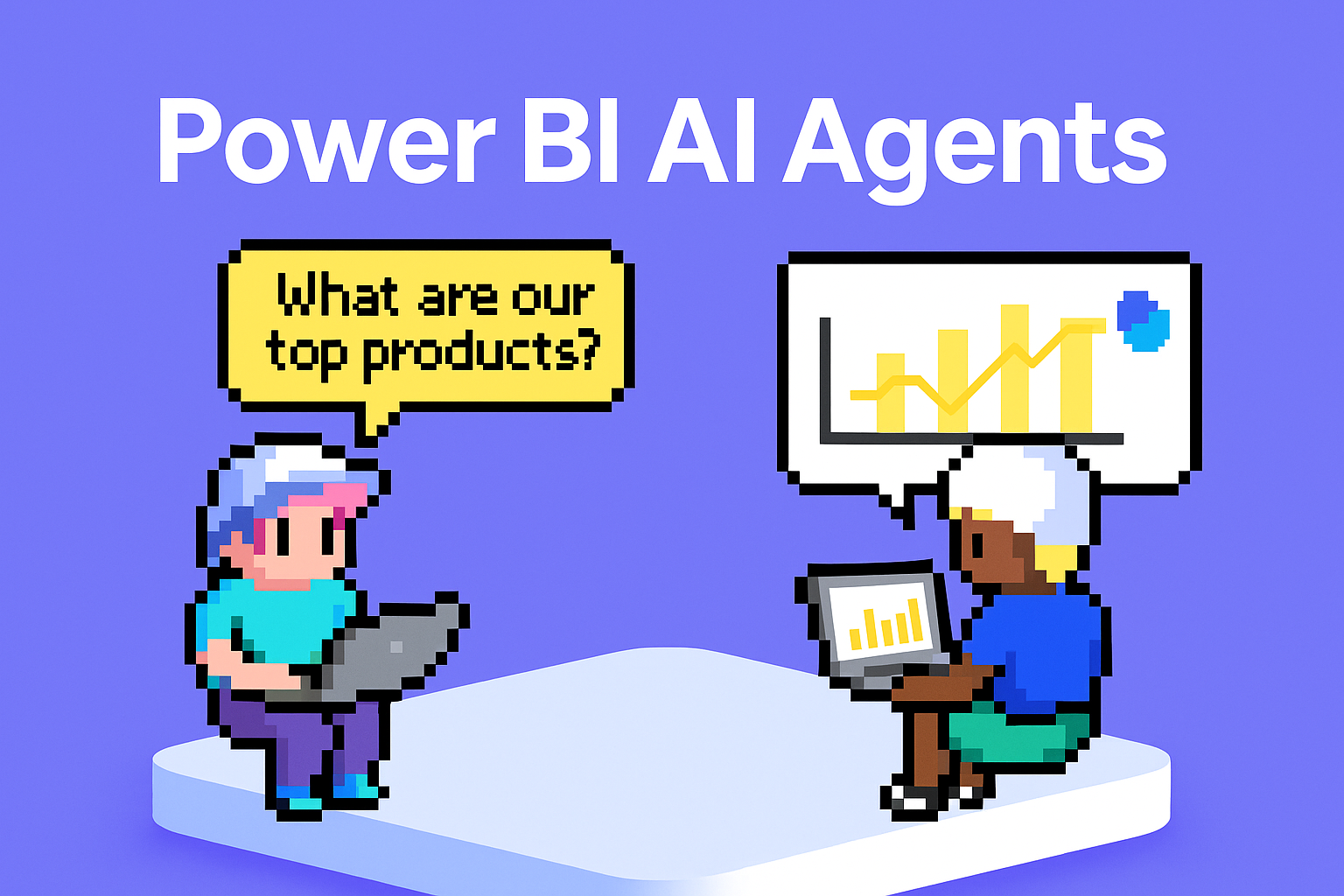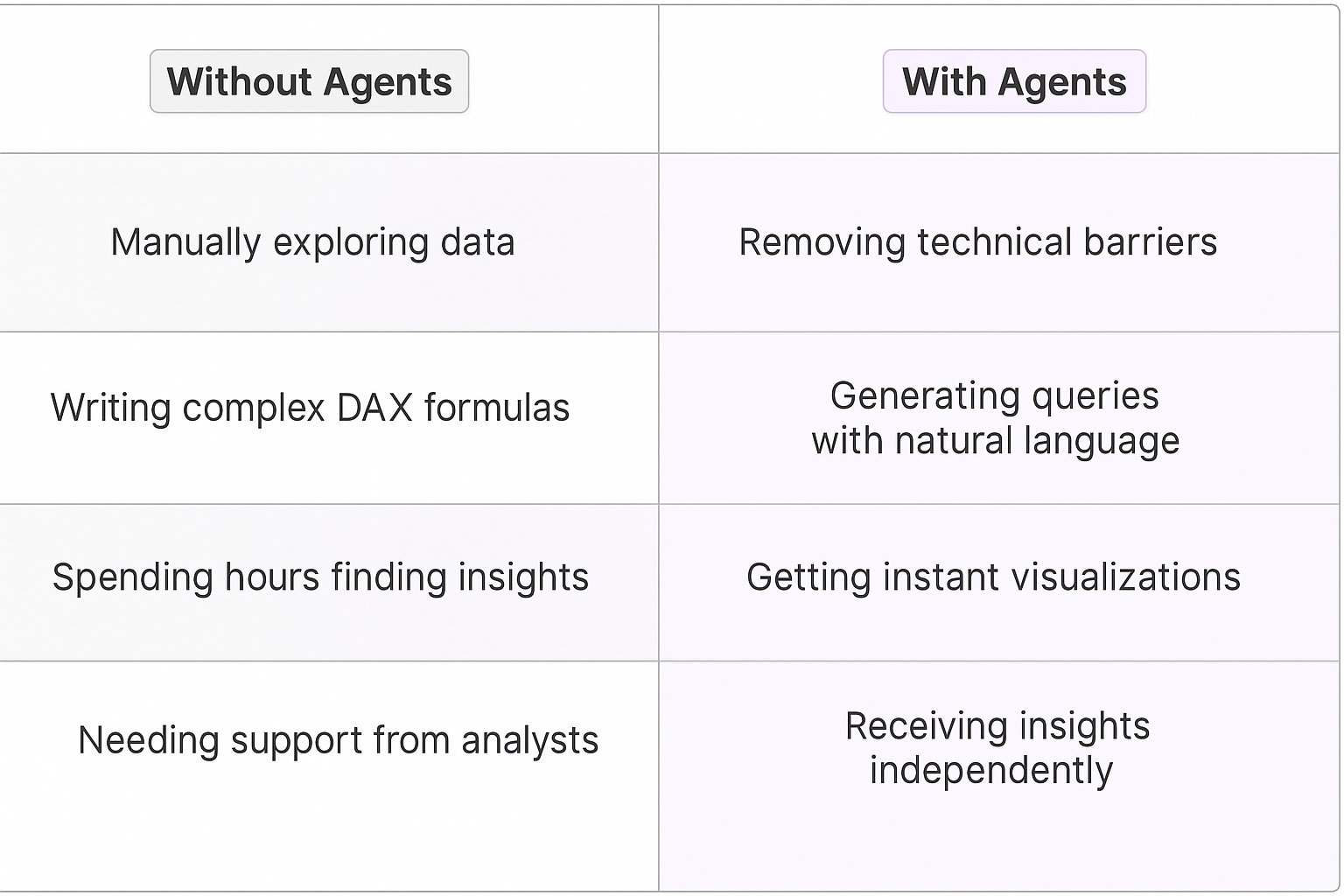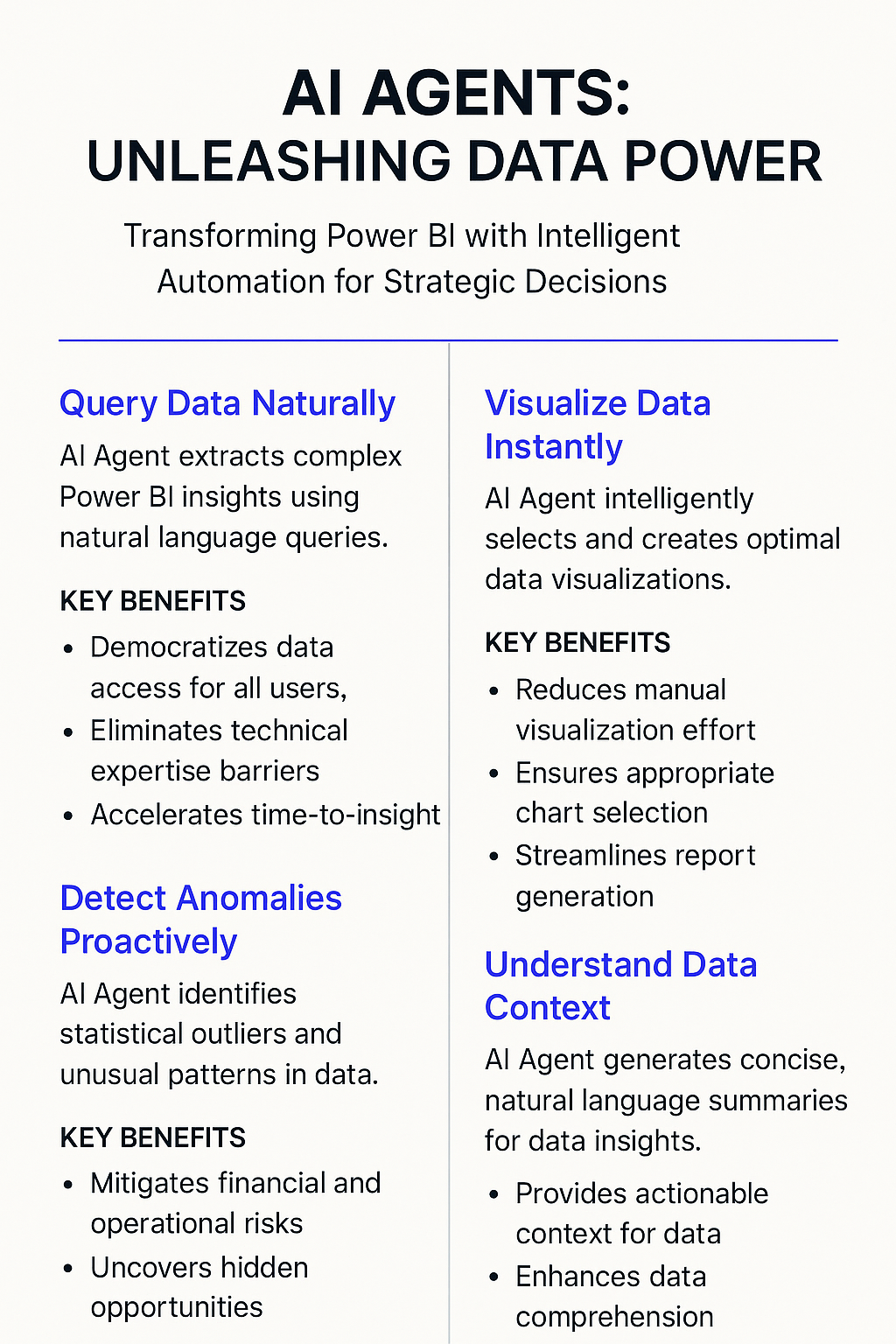Power BI
Understanding Power BI's Core Platform and Features
Power BI stands as Microsoft's flagship business intelligence platform, enabling organizations to connect, analyze, and visualize data from hundreds of sources. The platform combines robust data modeling capabilities with interactive visualizations, making it a cornerstone of modern business analytics. Unlike traditional BI tools that require extensive technical expertise, Power BI emphasizes accessibility while maintaining enterprise-grade analytical power.
The platform excels in data connectivity, offering seamless integration with databases, spreadsheets, and cloud services. Its DAX (Data Analysis Expressions) language enables sophisticated calculations and data modeling. The drag-and-drop interface for creating visualizations democratizes data analysis, while the sharing and collaboration features foster data-driven decision making across organizations.

Benefits of AI Agents for Power BI
What would have been used before AI Agents?
Power BI users traditionally relied on manual data exploration, writing complex DAX formulas, and spending hours clicking through visualization options to find meaningful patterns. They'd need to master intricate query languages, understand data modeling principles, and often required support from data analysts to extract valuable insights.
What are the benefits of AI Agents?
AI Agents transform the Power BI experience by removing technical barriers that previously blocked business users from accessing deep analytical capabilities. These digital teammates act as expert data analysts, handling complex tasks that once required specialized knowledge.
The most significant shift comes from natural language interactions. Users can simply ask questions about their data and receive instant visualizations, trend analysis, and actionable insights. For example, asking "show me sales trends by region for the last quarter" generates a complete analysis without touching a single formula or visualization tool.
Pattern detection becomes exponentially more powerful with AI Agents. They continuously scan datasets to surface anomalies, correlations, and trends that humans might miss, even with years of experience. This creates a multiplier effect - each user effectively gains the analytical capabilities of an entire data science team.
The agents also excel at data storytelling, automatically generating narrative explanations alongside visualizations. This bridges the gap between raw data and business decisions, making insights accessible to stakeholders across all technical levels.
For organizations scaling their data operations, AI Agents serve as force multipliers. They reduce the learning curve for new Power BI users while empowering experienced analysts to focus on strategic work rather than routine report generation and maintenance.
The network effects are particularly compelling - as more users interact with AI Agents in Power BI, the system becomes increasingly adept at understanding domain-specific terminology and business context, creating a virtuous cycle of improved analytics capabilities across the organization.
Potential Use Cases of AI Agents with Power BI
Processes
- Data cleaning and preparation automation - AI agents detect anomalies, standardize formats, and handle missing values across multiple datasets
- Natural language report generation - Converting complex visualizations into clear narrative insights for stakeholders
- Automated dashboard maintenance - Monitoring for broken connections, outdated data sources, and performance issues
- Cross-platform data integration - Seamlessly connecting Power BI with other data sources while maintaining data quality
Tasks
- Real-time data analysis with natural language queries like "Show me sales trends for Q2 in the Northeast region"
- Automated report scheduling and distribution based on custom triggers and conditions
- Dynamic visualization recommendations based on data types and relationships
- Predictive analytics modeling without requiring deep statistical knowledge
- Custom alert creation for specific metrics and thresholds
- DAX formula generation and optimization for complex calculations
The Growth Opportunity
Power BI's integration with AI agents represents a significant shift in how organizations handle business intelligence. The key insight is that AI agents remove the traditional barriers between data and decision-makers. When technical complexity no longer blocks access to insights, the network effects of data-driven decision making compound rapidly across organizations.
The most successful implementations focus on reducing friction in three critical areas: data preparation, insight generation, and knowledge distribution. AI agents excel at these tasks because they can operate continuously, learn from user interactions, and scale their capabilities across the organization.
Organizations that embrace this shift are seeing 3-4x improvements in dashboard adoption rates and significant reductions in time-to-insight. The competitive advantage comes from combining human strategic thinking with AI-powered data analysis - creating a multiplier effect on decision-making quality.
Implementation Strategy
The optimal approach starts with identifying high-friction workflows within existing Power BI processes. AI agents should first tackle repetitive tasks like data cleaning and report maintenance. As users gain confidence, expand to more complex use cases like natural language analysis and predictive modeling.
Success metrics should focus on time saved, increased dashboard adoption, and improved decision velocity. The goal isn't to replace analysts but to amplify their capabilities and free them to focus on strategic work that drives business value.

Industry Use Cases
AI agents are transforming how organizations extract value from Power BI analytics, creating a new paradigm in data-driven decision making. The integration of AI with Power BI enables teams to move beyond static dashboards into dynamic, conversation-driven analysis that adapts to specific industry contexts.
While traditional Power BI implementations require dedicated analysts to build and modify reports, AI agents serve as on-demand data interpreters - translating complex datasets into actionable insights through natural dialogue. This shift fundamentally changes how different sectors leverage their business intelligence.
The real power emerges when AI agents combine Power BI's robust visualization capabilities with industry-specific knowledge, enabling them to surface relevant metrics and generate custom views based on each sector's unique KPIs and reporting needs. From healthcare providers tracking patient outcomes to manufacturers monitoring production efficiency, these digital teammates adapt their data analysis approach based on the business context.
Let's explore how different industries are putting these capabilities to work in ways that create measurable business impact while reducing the technical barriers to data-driven insights.
Healthcare Analytics: How Power BI AI Agents Transform Patient Care
Healthcare organizations sit on mountains of patient data, but turning that data into actionable insights has historically required teams of analysts working overtime. Power BI AI Agents are changing this dynamic in profound ways.
Take a major hospital network managing patient readmission rates - a critical metric tied directly to both patient outcomes and revenue. The AI Agent can continuously monitor admission patterns across departments, analyze length of stay data, and identify high-risk patients before they're discharged.
What's particularly compelling is how the AI Agent handles the nuanced context of healthcare data. When a clinician asks "Why did cardiac unit readmissions spike last month?", the Agent doesn't just pull numbers - it correlates multiple data streams including staffing levels, procedure types, patient demographics, and seasonal factors to surface meaningful patterns.
The Agent becomes particularly valuable in predictive scenarios. By analyzing historical patient data, it can flag subtle indicators that often precede readmissions - medication adherence issues, social determinants of health, or gaps in follow-up care. This allows healthcare teams to intervene proactively rather than reactively.
But the real power comes from the Agent's ability to learn and adapt. As it processes more queries and receives feedback from healthcare professionals, it develops an increasingly sophisticated understanding of clinical contexts and priorities. It starts recognizing which metrics matter most for different specialties and can proactively surface relevant insights.
For healthcare administrators and clinicians, this means spending less time wrestling with data and more time focusing on patient care. The AI Agent essentially becomes a specialized healthcare analyst that's available 24/7, continuously monitoring metrics and surfacing actionable insights when they matter most.
Manufacturing Intelligence: Power BI AI Agents Decode Production Complexity
Manufacturing operations generate massive amounts of data across production lines, quality control systems, and supply chains. The challenge isn't data collection - it's extracting meaningful signals from the noise. Power BI AI Agents are proving to be game-changing partners for manufacturing teams.
A fascinating example comes from an automotive parts manufacturer dealing with quality control issues. The AI Agent detected subtle correlations between specific machine parameters, ambient temperature variations, and defect rates that human analysts had missed for months. By continuously monitoring these interrelated factors, the Agent helped reduce defect rates by 23% within the first quarter.
The Agent's ability to handle complex, multi-variable analysis shines in manufacturing environments. When plant managers ask questions like "What's causing the increased scrap rate on Line 3?", the Agent dives deep into historical data, examining everything from operator shift patterns to material batch numbers and maintenance records. It surfaces non-obvious connections that traditional BI tools might overlook.
Manufacturing teams are finding particular value in the Agent's predictive capabilities. By analyzing patterns in equipment sensor data, production schedules, and maintenance records, it can forecast potential bottlenecks or equipment failures before they impact production. This shifts maintenance from reactive to truly predictive.
The network effects in manufacturing AI are fascinating - as the Agent processes more queries across different production scenarios, it builds an increasingly sophisticated understanding of manufacturing processes. It starts recognizing common patterns in equipment behavior, quality issues, and supply chain disruptions across different product lines.
For manufacturing leaders, this means moving beyond basic monitoring to deep operational intelligence. The AI Agent becomes a specialized manufacturing analyst that understands the nuances of production processes and can spot opportunities for optimization that might otherwise go unnoticed.

Considerations and Challenges
Implementing Power BI AI agents requires careful planning and understanding of both technical and organizational dynamics. Organizations need to navigate several key areas to ensure successful integration.
Technical Considerations
Data quality stands as the foundation for effective Power BI AI agent performance. Raw data must be clean, properly formatted, and consistently structured. Missing values, inconsistent naming conventions, or corrupted datasets can severely impact the AI agent's ability to generate accurate insights.
Processing power and memory requirements increase significantly when AI agents analyze large datasets. Organizations often underestimate the computational resources needed, leading to slower query responses and potential system bottlenecks.
Security and Compliance
Power BI AI agents require access to sensitive business data, raising important security considerations. Organizations must implement robust authentication protocols and ensure data encryption both at rest and in transit.
Compliance with industry regulations like GDPR, HIPAA, or CCPA demands careful configuration of AI agent permissions and data access levels. Regular security audits become essential to maintain compliance standards.
User Adoption Challenges
Analytics teams often face resistance when introducing AI agents into existing Power BI workflows. Data analysts may worry about job security or question the reliability of AI-generated insights.
Training requirements extend beyond basic functionality. Users need to understand how to interpret AI-generated suggestions, validate results, and recognize potential limitations or biases in the analysis.
Integration Complexity
Power BI AI agents must seamlessly connect with existing data sources, warehouses, and business intelligence tools. Legacy systems or incompatible data formats can create integration bottlenecks that require custom solutions.
Version control becomes more complex when AI agents are involved. Organizations need robust processes to track changes in AI models, data sources, and report configurations.
AI-Enhanced Analytics: A Competitive Imperative
The integration of AI Agents with Power BI marks a fundamental shift in business intelligence. Organizations that successfully implement these digital teammates gain significant competitive advantages through faster insights, deeper analysis, and broader user adoption. The network effects of AI-enhanced analytics create a virtuous cycle where increased usage leads to better insights, driving further adoption across the organization. As AI capabilities continue evolving, the gap between organizations that embrace these tools and those that don't will likely widen, making this integration increasingly critical for maintaining competitive edge in data-driven decision making.
The future of business intelligence lies in the seamless integration of human expertise with AI-powered data analysis. Organizations that master this combination will find themselves with unprecedented analytical capabilities, while those that rely solely on traditional BI tools like Tableau may struggle to keep pace with the speed and depth of insights that AI-enhanced Power BI can deliver.











